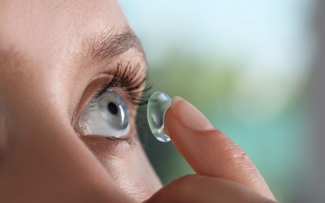How do contact lenses work?
Contact lenses are a popular alternative to glasses, thanks to the convenience, aesthetic appeal, and wider field of vision they provide. Your eye care professional may prescribe them to help you see more clearly or as a way to make temporary cosmetic changes.
Here are a few reasons some people prefer contacts over specs:
They seem to have a more natural feel.
- They may work better during high-intensity activities
- They don’t fog up.
Contact lenses come in a variety of styles and materials to suit different wearers’ eye and vision needs. [1]
How do contacts work?
Contact lenses work in a very similar way to glasses - and they’re both typically prescribed to correct refractive error. If you have a refractive error like myopia or hyperopia, objects appear blurry at some distances because light is not properly focused on the retina after it enters the eye.
Specifically:
- Myopia - With short-sightedness nearsightedness), light comes to a focus in front of the retina. This causes distant objects to appear blurry.
- Hyperopia - With long-sightedness (farsightedness), light comes to a focus behind the retina. This causes up-close objects to appear blurry, and it can sometimes affect the clarity of distant objects too.
Both contacts and glasses correct vision by bending light as it enters the eye. This helps the light rays focus directly on the retina rather than in front or behind it. By focusing the light properly, these corrective lenses allow your brain to process a clear image.
While glasses typically sit one or two centimeters in front of your eyes, contact lenses rest directly on the surface of your eyes. This is one of the main reasons your eyeglass prescription is different from your contact lens prescription.
What are multifocal contact lenses?
Multifocal contact lenses contain multiple prescriptions to correct vision at multiple distances. They are most commonly prescribed to correct presbyopia, which the natural loss of near focussing ability that comes with age.
Most people start to experience the effects of presbyopia starting around age 40, when the eyes’ natural crystalline lenses become less flexible. This makes it harder to read small text and focus on up-close objects.
How do multifocal contact lenses work?
Multifocal contacts - also called varifocal contact lenses - contain multiple prescription zones to correct your near, intermediate, and distance vision. There are two main types of simultaneous vision designs:
- Concentric – These bullseye-style lenses have concentric circles, correcting distance vision in the center with alternating rings of near and distance correction.
- Aspheric – Similar in design to progressive glasses lenses, there’s a gradual shift between strengths for a smoother visual transition. Distance vision is corrected in the centre, followed by intermediate, then near vision at the edge of the lens.
These design types may create a more natural visual experience than segmented bifocal or trifocal contacts.
How do contact lenses for astigmatism work?
Astigmatism is a type of refractive error that causes blurry vision at all distances. If you have mild astigmatism, you may feel that standard soft contacts provide effective correction. But if your astigatism is more severe, your optician may recommend a speciality contact lens.
The following specialty contacts may be used to correct astigmatism:
- Toric lenses – Soft contacts that mould with the meridians of the cornea, rotating to the proper point of correction when placed on the eyeball.
- Rigid gas-permeable (RGP) lenses – Hard contacts that maintain their shape on the eye’s surface to provide clear vision. The rigidity may take some getting used to, but these lenses are more durable and tend to provide sharper vision than softer lenses.
- Hybrid contact lenses – Hybrid contacts have a gas-permeable centre and a soft outer edge. This provides wearers with the sharper vision of RGPs, along with a higher level of comfort from the lenses’ soft edges.
Are you ready to give contacts a try?
If you think contact lenses may be right for you, book an eye test today. During an eye exam, your optician will check your eye health and vision, and ensure your current prescription is correct.
They can also talk with you about the pros and cons of contact lenses, and how well they might work for your lifestyle.
Sources
- Contacts. Cleveland Clinic. July 2023.
- Vision. Cleveland Clinic. December 2023.
- Nearsightedness: What is myopia? EyeSmart. American Academy of Ophthalmology. December 2023.
- Farsightedness (hyperopia). National Eye Institute. November 2023.
- How do contact lenses work? All About Vision. June 2019.
- Bifocal and multifocal contact lenses for presbyopia and myopia control. Journal of Ophthalmology. April 2020.
- What is presbyopia? EyeSmart. American Academy of Ophthalmology. May 2024.
- What are multifocal contact lenses? Vision Express. Accessed July 2024.
- A consumer guide to bifocal and multifocal contact lenses. All About Vision. February 2019.
- Astigmatism. Cleveland Clinic. November 2022.
- Which is better for astigmatism – glasses or contacts? EyeSmart. American Academy of Ophthalmology. June 2023.
- Contact lenses for astigmatism. All About Vision. February 2019.


